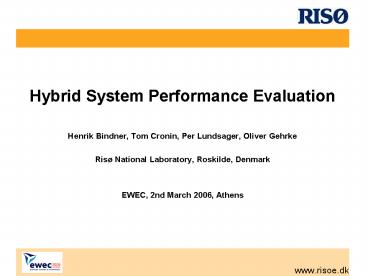Hybrid System Performance Evaluation - PowerPoint PPT Presentation
1 / 24
Title:
Hybrid System Performance Evaluation
Description:
Key Issue: Develop method for system performance assessment. Main ingredient: ... Droop Curve for Diesel Generators and Dump Load. www.risoe.dk ... – PowerPoint PPT presentation
Number of Views:81
Avg rating:3.0/5.0
Title: Hybrid System Performance Evaluation
1
- Hybrid System Performance Evaluation
- Henrik Bindner, Tom Cronin, Per Lundsager, Oliver
Gehrke - Risø National Laboratory, Roskilde, Denmark
- EWEC, 2nd March 2006, Athens
2
Hybrid System Performance Evaluation
- Hybrid Systems the Problem
- How will SYSTEM 1 perform at SITE 1?
- Is SYSTEM 1 better than SYSTEM 2 at SITE 2?
- Can you trust the answers?
- Key Issue
- Develop method for system performance assessment
- Main ingredient
- System modelling, especially supervisory
controller modelling
3
Hybrid System Performance Evaluation
- This Work the Questions
- The presentation deals with the following issues
of modelling of hybrid system - The optimum timestep to adequately take account
of the wind variability. - Sensitivity of various performance criteria to
the choice of timestep. - The nature of controller approximations necessary
for longer timesteps.
4
Hybrid System Performance Evaluation
- This Work the Approach
- Model simple system with 2 diesel gensets, 3 wind
turbines and 3 loads - Specify performance criteria
- Investigate performance for 2 different
controllers and for 3 different simulation time
steps
5
Hybrid System Performance Evaluation
- IPSYS an explanation
- IPSYS is a flexible framework for simulation of
integrated energy systems - IPSYS is a dispatch model - modelling timesteps
are in the range 10s-60min - IPSYS explicitly models the power system and does
load sharing between the frequency controlling
units - IPSYS is multi-domain it models the electrical,
mechanical, thermal, water or other domains - IPSYS is very flexible in modelling
configurations and supervisory controllers
6
Hybrid System Performance Evaluation
- Layout of the Simulated Hybrid System
7
Hybrid System Performance Evaluation
- Main System Details
- 2 x diesel generators 780kW
- Generation voltage 400V
- Step-up transformer 1.7MVA
- Distribution voltage 22kV
- 3 x 300kW wind turbines
- No-load reactive power compensation 250kVA
- 900kW dump load
- 3 x geographically dispersed loads
8
Hybrid System Performance Evaluation
- Load Profiles
9
Hybrid System Performance Evaluation
- Droop Curve for Diesel Generators and Dump Load
10
Hybrid System Performance Evaluation
Threshold Controller
Margin Controller
- Diesel Generator Controls
ON 75 Pr 570kW
Reserve Capacity (a load kW) (ß wind
kW) Controller turns on another diesel if
present generator cannot meet the current load
plus the Reserve Capacity. Controller turns
diesel off if it is not needed to meet the
current load plus the Reserve Capacity.
OFF 25 Pr 195kW
ON 75 Qr 510kVAr
OFF 25 Qr 170kVAr
11
Hybrid System Performance Evaluation
- Diesel Generator Fuel Curve
No-load offset
12
Hybrid System Performance Evaluation
- Graphical Output from IPSYS
13
Hybrid System Performance Evaluation
- Running of the Diesel Generators
1 min
10 min
Active Power (kW)
60 min
14
Hybrid System Performance Evaluation
- Numbers of Starts for Diesel No. 2 and Hours Run
15
Hybrid System Performance Evaluation
- IPSYS Outputs for this Assessment
- Total energy generated during the simulation
- Wind energy generated
- Wind usage
- Wind share
- Dump load share
- Diesel generator starts
- Diesel generator run time
- Total diesel fuel used
16
Hybrid System Performance Evaluation
- Simulation Cases Investigated
Base Case Threshold Controller Raw Wind Input
Threshold Controller with min runtime adjustments
Raw Wind Input
Threshold Controller Filtered Wind Input
Margin Controller Raw Wind Input
All simulations run with 1, 10 60 minute
timesteps
17
Hybrid System Performance Evaluation
- Accuracy is necessary in modelling limits in even
simple controllers.
Both controllers show a sensitivity to a change
in limits
18
Hybrid System Performance Evaluation
- .but the timestep can influence the effect.
The effect of changing the minimum run time is
reduced as the timestep is increased.
19
Hybrid System Performance Evaluation
- Timestep impact on long-term performance
indicators is relatively small
20
Hybrid System Performance Evaluation
- Major impact of timestep is on diesel start/stops
21
Hybrid System Performance Evaluation
- Impact of Wind Sampling Period (1)
Power Frequency Filter
Raw Wind Data Series
22
Hybrid System Performance Evaluation
- Impact of Wind Sampling Period (2)
23
Hybrid System Performance Evaluation
- Conclusions
- Simulation timestep has only a limited impact on
overall system performance in terms of fuel
consumption and wind usage - Simulation timestep has a significant impact on
operating conditions of components e.g. number of
start/stops of genset - Wind filtering has only minimal impact on fuel
consumption - For feasibility studies long timesteps (1h) give
results of adequate accuracy - Short timesteps (1min) are necessary for study of
controllers and interaction between components,
component operating conditions and wear and tear - It is important to model reactive power aspect of
controllers, as this has a considerable impact on
the system operation and simulation results. - Short time steps will allow real controllers to
be implemented in simulation tool IPSYS is
designed for that
24
Hybrid System Performance Evaluation
- Limitations on Results
- Only one hybrid system configuration has been
simulated. - No storage included in studied configuration.
- Only simple controllers investigated.
- System parameters were adjusted to ensure all
runs at all timesteps would run this could hide
the full of impact of timestep changes. - Only a short step towards system testing Lots
of work required































